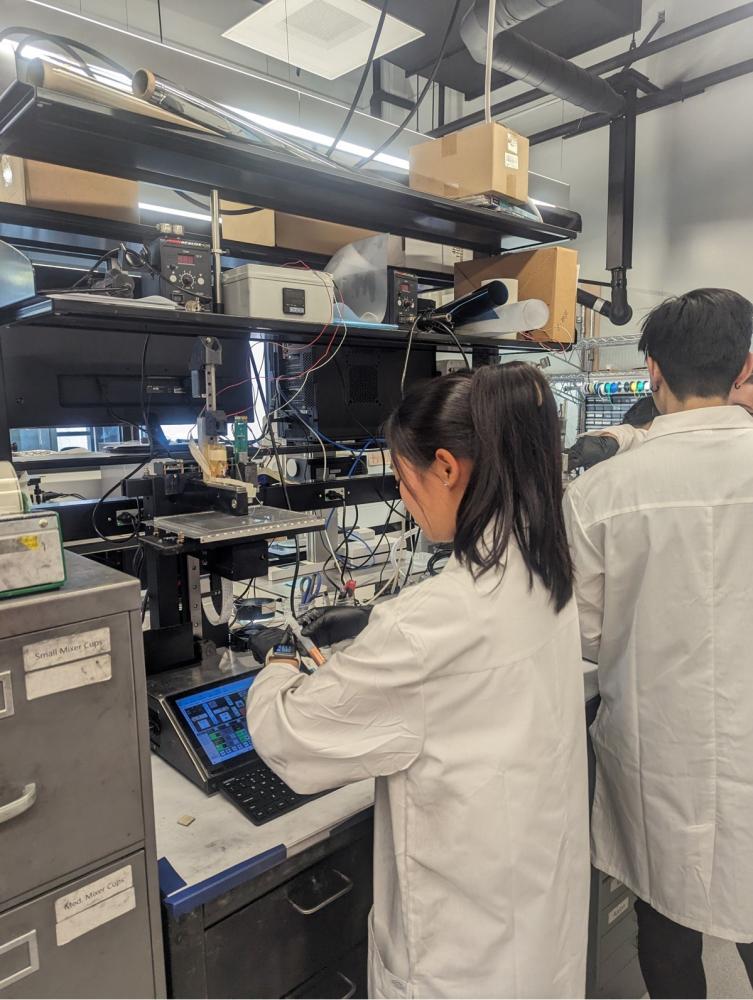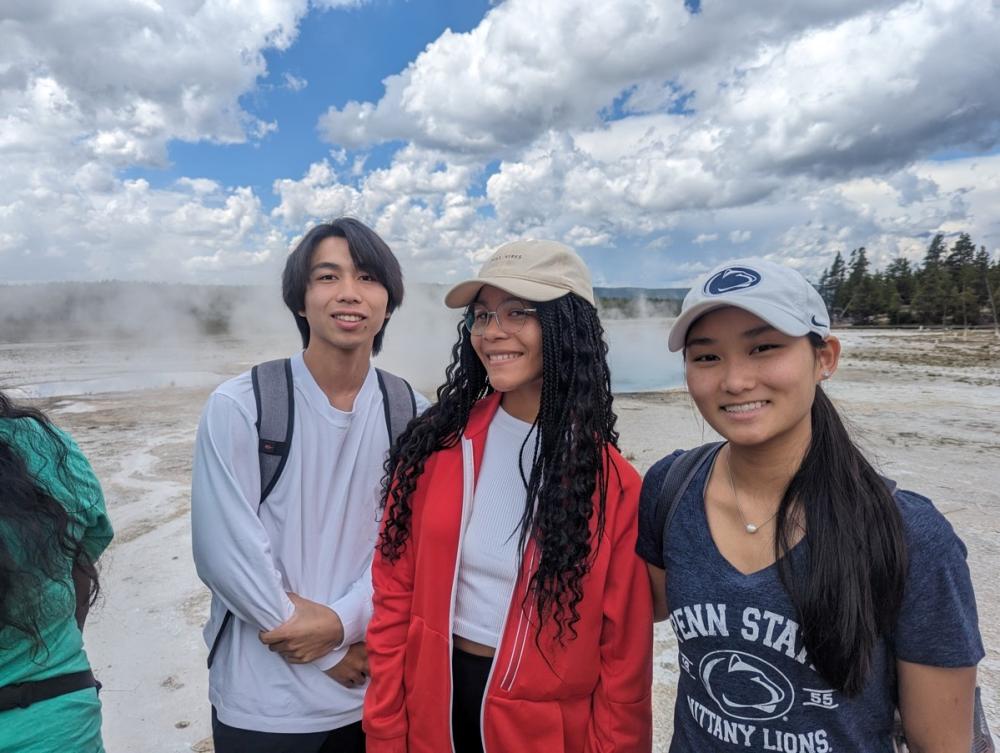
DISCOVER AND INNOVATE WITH LEADING-EDGE NANOSCALE SCIENCE AND ENGINEERING INSTRUMENTATION
For information contact
Education/Outreach Coordinator, Nebraska Center for Materials & Nanoscience

Who should apply
Related fields
- Physics
- Mechanical Engineering
- Materials Engineering
- Electrical Engineering
- Chemistry
- Civil Engineering
- Chemical Engineering
- Other related fields
Eligibility
Participation in the Nebraska Summer Research Program is limited to students who meet the following criteria:- U.S. Citizen or Permanent Resident
- Current undergraduate with at least one semester of coursework remaining before obtaining a bachelor's degree
See Eligibility for more information.
How to apply
Follow the application steps to submit the following materials.
About the Program
The Nebraska Nanoscale Facility (NNF) is a member of the NSF-funded National Nanotechnology Coordinated Infrastructure (NNCI) program which includes 16 major research centers in nanomaterials throughout the US. NNF, with support from the Nebraska Center for Materials and Nanoscience (NCMN) provides researchers from academia, government, and industry access to facilities with leading-edge instrumentation which enables innovations, discoveries, and contributions to education and commerce.
NNF offers a 10-week summer fellowship that provides undergraduate students with an opportunity for interdisciplinary research in a nanoscale science or engineering laboratory on the University of Nebraska-Lincoln campus. The Nebraska Nanoscale Facility summer research REU includes faculty mentors from the following university departments: Physics, Mechanical & Materials Engineering, Electrical and Computer Engineering, Civil Engineering and Chemical Engineering. The fellowships will carry a $6,000 stipend for ten weeks of research.

Benefits
- Competitive stipend: $6,000
- Suite-style room and meal plan
- Travel expenses to and from Lincoln
- Campus parking and/or bus pass
- Full access to the Campus Recreation Center and campus library system
- Wireless internet access
Learn more about academic and financial benefits.
Events
- Department seminars and presentations
- Professional development workshops (e.g., applying to graduate school, taking the GRE)
- Welcome picnic
- Day trip to Omaha's Henry Doorly Zoo and Aquarium
- Outdoor adventures
- Research symposium
Mentors and Projects
Prof. Shireen Adenwalla Physics and Astronomy
Magnetic domains and their response to high frequency sound waves
We are looking at how magnetic domains respond to high frequency sound. Although at first sight this may seem pretty wild, sound is just a squeezing and stretching of atoms. As atoms alternate between moving further apart and closer together, their interactions between themselves and the surrounding change in unexpected and complicated ways. So looking at how sound waves change magnetic domains (and we already know that they DO!), helps us unravel this complex interplay.
Prof. Kirill Belashchenko Physics and Astronomy
First-principles studies of spin transport in magnetic nanostructures
This computational project is focused on the transport properties and magnetization dynamics in magnetic nanostructures. The student will be trained to perform first-principles electronic structure and transport calculations and apply them to a research problem of current interest. Knowledge of quantum mechanics and solid-state physics and some experience with the Linux operating system are desirable, but the training plan can be tailored to the background and interests of the specific student.
Dr. Bai Cui Mechanical & Materials Engineering
Advanced Manufacturing of High-Temperature Alloys
To enable high-temperature operations, new materials will be required with high strengths in a variety of extreme environments in advanced energy applications. A promising class of novel materials known as oxide-dispersion-strengthened (ODS) alloys have the potential to perform in these environments. Spark plasma sintering and laser additive manufacturing processes have emerged as the promising approaches that can produce outstanding ODS alloys with nanoparticle dispersions in microstructures.
Dr. Shudipto Dishari Chemical and Biomolecular Engineering
Exploring ion-conducting polymeric nanomaterials for renewable energy technologies
Ion-conducting polymers play a critical role in the function of sustainable energy technologies, such as fuel cells and batteries. These polymers are used to selectively transport ions across the electrochemical cells. However, the current understanding of these polymers at nanoscale is still not up to mark. Understanding the routes to ion transport limitation within sub-micrometer thick polymer layers on electrodes is the key to design more efficient, next-generation fuel cells and batteries for electric cars and many portable/stationary applications.
Dr. Peter A. Dowben Physics and Astronomy
Organic heterostructures can be made that have similar functionality to oxide and semiconductor devices
This project will focus on magneto-electric organic or hybrid organic & inorganic heterostructures. The hybrid nanostructures will be characterized by electron spectroscopies and luminescence. If possible, simple device structures will be fabricated and tested. The goals are new classes of devices suitable as reactive luminescence sensors, or devices that could exhibit unusual behavior in an electromagnetic field.
Prof. Xia Hong Physics and Astronomy
Characterizations of epitaxial complex oxide thin films and heterostructures
In this project, the student will participate in the characterization of epitaxial ferroelectric and magnetic oxide thin films and heterostructures using x-ray diffraction, atomic force microscopy, and piezoresponse force microscopy.
Dr. Nicole Iverson Biological Systems Engineering
Development of Carbon Nanotube Sensor Platform to Quantify Nitric Oxide and Hydrogen Peroxide Levels in Inflammatory Diseases
Reactive oxygen and nitrogen species have been shown to be important factors in the progression of many diseases, ranging from autoimmune disease to cancer, but until recently there has been a lack in the ability of researchers to study nitric oxide and hydrogen peroxide (key reactive nitrogen and oxygen species) in real time. By wrapping carbon nanotubes with a specific DNA strand, a real time sensor for nitric oxide or hydrogen peroxide can be made. A carbon nanotube sensor platform has been developed by the Iverson Lab to allow for the quantification of extracellular nitric oxide concentrations. The development of a nitric oxide and hydrogen peroxide platform might sound easy and straightforward, but there are a lot of design aspects that will be needed to successfully create a working platform.
Dr. Forrest Kievit Biological Systems Engineering
Engineering Nanomedicine for the Neurosciences
The field of nanomedicine offers the potential to improve the understanding and treatment of many disease processes by allowing researchers and clinicians the ability to deliver treatments to specific areas of the body, image where the treatments are going in real-time, and track responses. Therefore, the development of multifunctional nanoparticles has garnered significant attention especially for improving delivery into the brain for neurological diseases including traumatic brain injury, brain cancer, and dementia for which there is a significant lack of effective treatment options.
Prof. Alexey Kovalev Department of Physics and Astronomy
Magnetic textures and spin current flows
The project is concerned with studies of spin currents in magnetic insulators. Student will learn how to perform micromagnetic simulations using Holland Computing Center or other sources of high performance computing, collaborating with other group members. In addition, we also study how magnetic textures such as skyrmions can be controlled in nanosctructures by sound waves.
Prof. Abdelghani Laraoui Mechanical & Materials Engineering
Nanoscale imaging of magnetic phenomena in solid-state materials using diamond quantum sensors
Understanding the behavior of spins in materials is at the heart of condensed matter physics. In the past few decades, a wide range of new materials showing exciting new magnetic phenomena has been discovered and explored. Current characterization techniques do not provide the combined spatial resolution and sensitivity required to map their properties at the nanometer scale. Recently, a new technique has emerged for measuring physical properties (magnetic, optical, electrical…) at the nanoscale based on optical detection of the electron spin magnetic resonance of nitrogen vacancy (NV) centers in diamond [Nat. Rev. Mater. (January 2018)].
Dr. Yongfeng Lu Electrical and Computer Engineering
Flexible and precise micromachining of ultrathin glasses by dual-wavelength, pulse tunable, high-power femtosecond laser
Ultrathin glasses have great supplication for electronics, displays, and sensing devices. There has been an increased interest from both industry and academia to develop techniques for micromachining ultrathin glasses (< 500 µm) with high quality and efficiency. Glass is a brittle material; however ultrathin glasses have a greater flexibility to them. Because of these properties any micro cracks or edge property changes post processing can cause the samples to break more easily. We believe femtosecond laser machining can solve the issue of cutting and drilling ultrathin glasses in a fast and cost efficient manner without the potential post process damages.
Dr. Eric Markvicka Mechanical and Materials Engineering
Additive manufacturing of functional emulsions
Functional emulsions are an emerging material architecture for creating highly functional elastomer composites that are soft and elastically deformable [1]. However, techniques to control local composition and microstructure of the composite material in emulsions, which ultimately govern material properties and performance of the cured elastomer composite, are lacking. For this project, the REU student will work closely with a graduate student to develop an additive manufacturing technique to control liquid inclusion microstructure in emulsions to achieve unprecedented combinations of thermal, electrical, and mechanical functionalities in elastomer composites.
Prof. Sangjin Ryu Mechanical & Materials Engineering
Fabrication of microfluidic devices mimicking insect wing vein network
The objective of this project is to fabricate microfluidic devices that mimic the vein network of insect wings for purposes of studying the blood flow or circulation through insect wings and for inventing biomimetic devices. A participating student will learn about basic fabrication methods for microfluidics, flow measurement methods such as flow visualization, and analysis methods such image processing.
Prof. Yanan (Laura) Wang Electrical and Computer Engineering
Design and Fabrication of Photonic Devices Based on Two-Dimensional Materials
As the 2010 Nobel Prize in Physics was awarded for the discovery of graphene, the family of two-dimensional (2D) materials has flourished and demonstrated their technological importance in various research fields. This project will employ the peculiar properties of 2D materials, including graphene, transition metal dichalcogenides, and hexagonal boron nitride, and explore their applications in nanophotonics. The REU student will work closely with a postdoctoral researcher or a graduate student and acquire a set of skills in device design and nanofabrication.
Prof. Xiaoshan Xu Physics and Astronomy
Novel Complex Oxide
Complex oxides exhibit various properties, such as ferromagnetism, ferroelectricity, superconductivity, magnetoresistance, etc. These properties owe to their complex crystal structure and electronic structures. Despite decades of research on complex oxides, which include at least two metal elements, the majority of these materials haven’t been thoroughly investigated, due to large number of metal elements, various compositions, and a plethora of crystal structures.
Dr. Ruiguo Yang Mechanical and Materials Engineering
3D Tissue Fabrication for Skin Regeneration
The project aims to use 3D bioprinting to fabricate in vitro tissue models. Specifically, the ongoing work is to recreate a 3D layered skin tissue. The research work will take advantage of the different types of state-of-the-art 3D tissue printing platforms to contribute to the broad literature of biotechnology. In addition, the students will learn tissue culture and regeneration, biological characterization, advanced microscopy as well as engineering design.